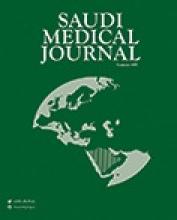Abstract
OBJECTIVE: To document the pattern of medical diseases necessitating admission in a tertiary care hospital during Muslim pilgrimage (Hajj). To assess the risk factors associated with mortality during hospitalization.
METHODS: The study was conducted at Al Noor Specialist Hospital, a 550-bed tertiary care teaching hospital, in Makkah, KSA. The participants included all Hajj patients admitted in the Department of Medicine in a 5-week period (January 3 to February 6, 2005) during the 2005 (1425 AH) Hajj. Information about demographics; past medical history; pre-Hajj functional status; presence of language barrier and translator availability; diagnosis for admission and complications during hospitalization including mortality was obtained prospectively using a standardized form.
RESULTS: Six hundred and eighty-nine patients, belonging to 49 countries, with mean age of 62 years and male:female ratio of 1.8:1 were admitted. Two hundred-twenty (31.9%) had diabetes mellitus, 256 (37.2%) had hypertension, 219 (31.8%) had cardiac disease, and 103 (14.9%) patients had chronic lung disease. Of the 449 (65.2%) patients assessed, 284 (63.2%) patients had language barrier, and translator was not available for 152 (53.5%) of them. Pre-Hajj functional status assessment of 240 patients showed that 20 (8.3%) required assistance in performing activities of daily living (ADL), and 40 (16.7%) could not walk for half kilometer without difficulty. Common causes of morbidity were: 235 (34.1%) cardiovascular, 137 (19.9%) infectious and 85 (12.3%) neurological diseases. One hundered and fourteen (16.5%) patients died, with the common causes being pneumonia (28 patients), acute coronary syndrome (21), and stroke (20). The risk factors associated with higher mortality were older age (65 ± 1 versus 61 ± 0.6 years, p=0.008), prior history of chronic lung disease (crude odds ratio, 1.81, p=0.034), dependence in any ADLs (4.90, p=0.025), inability to ambulate for half kilometer without difficulty (4.17, p=0.017) and non-availability of translator for patients with language barrier (5.51, p<0.0001).
CONCLUSION: Most patients were elderly with high prevalence of chronic medical disorders. Non-infectious diseases accounted for most morbidity and mortality. Pre-Hajj functional assessment should be carried out to identify patients at high risk of mortality. Provision of translator services for patients with language barrier is essential to improve future outcomes.
- Copyright: © Saudi Medical Journal
This is an open-access article distributed under the terms of the Creative Commons Attribution-Noncommercial License (CC BY-NC), which permits unrestricted use, distribution, and reproduction in any medium, provided the original work is properly cited.






